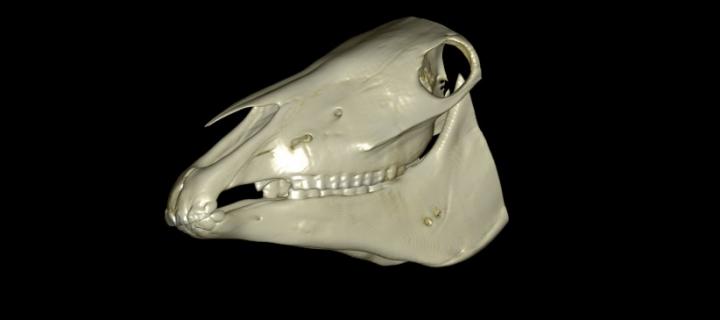Shape analysis offers insight on horses’ dental problems
CT Scans and statistical analysis reveal that bone development in equine skulls varies with age.
Common dental problems in horses – such as crowded teeth in Shetland ponies – could be better understood following a study of horses’ skulls.
The research, carried out using advanced imaging facilities in combination with statistical analysis, have revealed how horses’ skull bones grow at varying rates based on age.
Findings from the first study of its kind could aid understanding of conditions such as overbite, a common abnormality, and gaps between teeth, which affect half of all horses and can cause pain.
Bone growth

Experts from the Royal Dick School of Veterinary Studies’ Equine Hospital examined CT scans of heads of horses of varying ages.
They carried out geometrical analysis of the shape of the skull bones in each animal, to discover that skull bones grow at varying rates depending on age.
Their findings could help explain the origins of overbite, a developmental condition common in thoroughbreds.
They could also help address overcrowding in teeth, which is common in small breeds such as Shetland ponies.
The results also aid understanding of gaps between teeth at the back of the mouth, known as cheek teeth diastemata, which are thought to be caused by an imbalance between jaw size and tooth size and orientation.
Managing conditions
Researchers say genetic studies of horses affected by these conditions could be combined with the findings from their CT analysis to aid understanding of how the abnormalities occur and point towards ways to manage them.
The images were taken using a CT scanner designed for imaging heads of equine animals – the scanner, mounted on a hydraulic table, is the only such ensemble in veterinary use in the UK.
Horses may be scanned standing while mildly sedated, which brings a range of benefits for the animal and attending vets – reducing preparation and recovery time while minimising risk of injury.
The study will help support efforts to maintain dental health in horses, which can be challenging because horses’ teeth grow throughout their lifetimes.
The study was published in Veterinary Research Communications.
Our improved understanding of how skull bones develop in horses opens the door to more investigations into the origins of common, serious dental conditions. We hope that gene studies can be carried out which, combined with our new data on skull shape, could help us understand how common problems arise.
Related links
About the Royal Dick School of Veterinary Studies
The Royal (Dick) School of Veterinary Studies is a one-of-a-kind centre of excellence in clinical activity, teaching and research. Our purpose-built campus, set against the backdrop of the beautiful Pentland Hills Regional Park, is home to more than eight hundred staff and almost fourteen hundred students, all of whom contribute to our exceptional community ethos.
The School comprises:
- The Roslin Institute
- The Global Academy of Agriculture and Food Security
- The Roslin Innovation Centre
- The Hospital for Small Animals
- Equine Veterinary Services
- Farm Animal Services
- Easter Bush Pathology
- The Jeanne Marchig International Centre for Animal Welfare Education
We represent the largest concentration of animal science related expertise in Europe, impacting local, regional, national and international communities in terms of economic growth, the provision of clinical services and the advancement of scientific knowledge.


